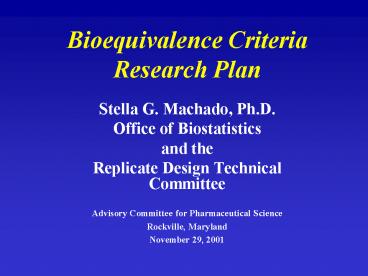Bioequivalence Criteria Research Plan - PowerPoint PPT Presentation
1 / 12
Title:
Bioequivalence Criteria Research Plan
Description:
Background Guidances for Industry Bioavailability and Bioequivalence Studies for Orally Administered Drug Products ... including both genders, ... – PowerPoint PPT presentation
Number of Views:167
Avg rating:5.0/5.0
Title: Bioequivalence Criteria Research Plan
1
Bioequivalence Criteria Research Plan
- Stella G. Machado, Ph.D.
- Office of Biostatistics
- and the
- Replicate Design Technical Committee
Advisory Committee for Pharmaceutical
Science Rockville, Maryland November 29, 2001
2
Background
- Guidances for Industry
- Bioavailability and Bioequivalence Studies for
Orally Administered Drug Products - General
Considerations October 2000 - Statistical Approaches to Establishing
Bioequivalence January 2001 - Advisory Committee for Pharmaceutical Science
Meeting 9/23/1999 - Discussed FDA plans for further research and
projects associated with the use of ABE and IBE
criteria
3
Background continued
- ACPS endorsed plans for furthering mechanistic
understanding, clinical pharmacology studies,
influence of outliers on SxF interaction - ACPS requested creation of research document to
guide activities during an interim period - Document sent for review (9/1999) to Population
and Individual BE Expert Panel - Draft Research Document modified by Population
and Individual Working Group of CDERs
Biopharmaceutics Coordinating Committee in
response to comments received (4/2000)
4
Research Program Overview
- Goal is to provide information to support final
regulatory decisions regarding criteria for
comparing BA in BE studies - Research Plan has 3 projects
- A) Criteria for BE comparisons
- B) Data analyses and Statistical Methodology
- C) Mechanistic understanding of Mean and
Variances differences between T and R
5
Program overview - continued
- Studies conducted by drug sponsors will be major
source of data for our evaluations - General Guidance recommends replicate designs for
highly variable drugs and modified release dosage
forms
6
A) Criteria for BE comparisons
- Choice of ABE, IBE criteria for BE studies in
particular types of regulatory submissions IND,
NDA, ANDA and post-approval supplement filings - Replicate-designed data sets are analyzed upon
receipt, and interpreted in light of
recommendations in Guidance - These analyses add to knowledge base for
evaluating performance of approaches
7
A) Criteria for BE comparisons - continued
- Identify and evaluate
- clinically important T/R differences in within-
and between-subject variances, and SxF
interactions - importance and impact of mean/variance trade-offs
- other outcomes based on selected disaggregate
criteria - study discontinuity aspect of IBE and possible
resolution
8
B) Data Analysis and Statistical Methodology
- Criteria and methods for assessing ABE and IBE as
laid out in the Guidance are reasonable and valid
- open to new approaches - as yet no persuasive
alternatives have been presented - Primary objectives
- assess estimation methods in presence of missing
data - assess properties of estimates of parameters of
interest - assess impact of apparent outlier data on
properties of aggregate IBE criterion
9
B) Data Analysis and Statistical methodology -
continued
- Secondary objectives
- monitor and assess carryover effects using data
from replicate designs - assess numbers of subjects and good study designs
for heterogeneous populations, including both
genders, different ethnic groups and different
age ranges
10
C) Mechanistic Understanding
- Develop mechanistic understanding as needed for
- important differences in means
- important differences in within subject
variances for Test and Reference products for
highly variable and modified release drug
products - subject-by-formulation interactions
11
Focus for immediate future
- continue evaluation of replicate designed studies
as received - address design and other issues via simulation
studies - evaluate impact of changing constraint on mean
difference - respond to recommendations of ACPS
12
Concluding remarks
- some issues in 4/2000 Research Plan were
addressed and incorporated into Guidances - now in evaluation phase of data sets and
performance of estimation methods































